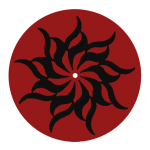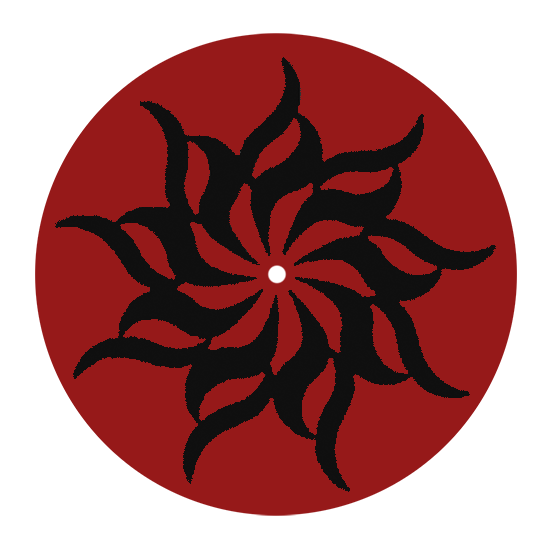नवकरण तन्त्र
Navakaraṇa Tantra
A brief on Navakaraṇa Tantra
Introduction to Navakaraṇa Teacher Training Courses
- List of Teacher Training Courses
- Highlights on Navakaraṇa Vinyāsa Hṛdayam
- What is Navakaraṇa Vinyāsa?
What is Navakaraṇa Tantra ?
Navakaraṇa Sākalya Tantra (or shorten Navakaraṇa Tantra) is a methodology for a “self-directed holistic transformation”. Conceived by Dario Calvaruso through a multidisciplinary integration of ancient practices into a modern scientific approach. Navakaraṇa is today taught by several teachers internationally.
The objectives of Navakaraṇa Tantra
The objectives of Navakaraṇa Tantra is to provide to the practitioner (navakaraṇi) the art, methodology, tools and techniques for expanding consciousness to its purest form (caitanya), discover his/her true meaning and purpose of life (dharma) and ultimately reach harmony and oneness with the Universe (aikātmya).
Navakaraṇa Tantra is subdivided in three main limbs:
Navakaraṇa Svasthavṛtta: self-transformation through lifestyle;
Navakaraṇa Vyāyāma: self-transformation through physical, prāṇic and mental training;
Navakaraṇa Mārgaṇa: self-transformation through awakening (bodhana).
Svasthavṛtta (natural path for healthy living)
Svasthavṛtta (natural path for healthy living) consists in creating a personalised lifestyle in harmony with the Universe. The navakaraṇi go through a meticulous purification process (śodhana) of body, mind and sense. This is achieve through the navakriyā (nine cleanses). Thereafter the navakaraṇi can implement a personalised holistic life-style in to daily life. This includes therapy for pacifying the vitiated doṣa-s (śamana), personalised wholesome diet and regiment (pathyavṛtta), conscious living (sadvṛtta), rejuvenation procedures (rasakaraṇa) and strengthening procedures(vājīkaraṇa).
Navakaraṇa Vyāyāma
Once the navakaraṇi has established a personalised holistic lifestyle can obtain implement a particular set of physical and mental trainings (vyāyāma) to maintain health and improve his/her wellbeing. Navakaraṇa Vyāyama consists in the application of a peculiar methodology for training referred as “Navakaraṇa Vinyāsa”.
The Navakaraṇa Krama Maṇḍala consists of a circle Navakaraṇa Vinyāsa sequences choreographed and synergistically arranged to moon-cycle (candra-māsa and seasons (kāla).
Navakaraṇa Krama maṇḍala comprises three collections (mālā):
Navakaraṇa Vinyāsa Bheṣaja krama mālā (collection of healing sequences)
Navakaraṇa Vinyāsa Hṛdayam krama mālā (collection of essentials sequences)
Navakaraṇa Vinyāsa Prakṛṣṭa krama mālā (collection of advance sequences).
The “Bheṣaja krama mālā” is a set of sequences for those who want to reach optimal health. The Hṛdayam krama mālā for the healthy who want to maintaining their health, and the Prakṛṣṭa krama mālā for those who want to unfold their potentials to the maximum. Through the implementation of Svasthavṛtta (natural path for healthy living) and Navakaraṇa Vyāyāma (self-transformation through physical, prāṇic and mental training) the navakaraṇi can access the practice of somarakṣa karaṇa (the process of preserving soma) and medhya-karaṇa (the process for achieving excellence of intellect, mind, body and senses), therefore obtaining a complete “self-directed and personalised holistic transformation” (Navakaraṇa Sākalya Tantra).
Navakaraṇa Mārgaṇa:
Navakaraṇa Mārgaṇa is the most subtle aspect of our practice. The navakaraṇi is guided in discovery is personal purpose and meaning of life (dharma). This is possible only by expanding consciousness to its purest form (caitanya) through profound thoughts, reflections considerations, discussions, ontological self-enquiries, spiritual measures (daivavyapāśraya) and ultimately reach harmony and oneness with the Universe (aikātmya).The first step in learning Navakaraṇa is the Navakaraṇa Vyāyāma as it is the most efficacious way to lead the navakaraṇi naturally into Svasthavṛtta (natural path for healthy living) and eventually into Navakaraṇa Mārgaṇa. Thus the process of learning Navakaraṇa (viz.: Vyāyāma, Svasthavṛtta and Mārgaṇa) is different from process of implementing Navakaraṇa Tantra (viz. Svasthavṛtta, Vyāyāma, Mārgaṇa).
The first step in learning Navakaraṇa strat with Navakaraṇa Vyāyāma as it is the most efficacious way to lead the navakaraṇi naturally into Svasthavṛtta (natural path for healthy living) and eventually into Navakaraṇa Mārgaṇa. Thus the process of learning Navakaraṇa Tantra (viz.: Vyāyāma, Svasthavṛtta and Mārgaṇa) is different from process of implementing Navakaraṇa Tantra (viz. Svasthavṛtta, Vyāyāma, Mārgaṇa).
Navakaraṇa Teacher Training Courses
Navakaraṇa teacher training courses are meant to guide the students in leaning how to practice and teach the Navakaraṇa Vināsa Krama Maṇḍala (a cyclic-collection of sequences).
The Teacher Training is divided in the following courses:
Navakaraṇa Sākalya Tantra
Navakaraṇa Sākalya Tantra focuses on the principle of the self-healing (svasthavṛtta) and study of a collection of sequences named Bheṣaja krama mālā (A collection of healing sequences).
Navakaraṇa Vinyāsa Hṛdayam (this course is open for registration – view details)
Navakaraṇa Vinyāsa Hṛdayam which focuses on the essentials for vinyāsa practice and teaching acquired through a collection of sequences called Hṛdayam krama mālā (A collection of essential sequences)
Prakṛṣṭa
Prakṛṣṭa a subsidiary course to Navakaraṇa Vinyāsa Hṛdayam which prepares the trainees for the practice and teaching of advanced sequences named Prakṛṣṭa krama mālā (A collection of advanced sequences). This syllabus is generally taught one-to-one.
Navakaraṇa Śikṣā Paddhati
Navakaraṇa Śikṣā Paddhati or an in-depth course on Navakaraṇa methodology and teaching skills necessary to acquired complete understanding and mastery in teaching.
What is Navakaraṇa Vinyāsa?
What I learn in the Teacher Training Course Navakaraṇa Vinyāsa Hṛdayam ?
Navakaraṇa Vinyāsa (lit. composition of 9 units of movement) is a methodology for self-transformation through physical, prāṇic and mental training.
Self-transformation through physical, prāṇic and mental training
The first step in Navakaraṇa is to educate the practitioner (nava-karaṇi) at the physical, prāṇic and mental level. For this reason, the practitioner (nava-karaṇi) has to complete the teacher’s training course Navakaraṇa Vinyāsa Hṛdayam (lit. The essentials of Navakaraṇa Vinyāsa). This course, also called “The Essentials” consists mainly of physical, prāṇic and mental training. The practitioner (navakaraṇi) learns how to practice and teach a collection of 12 series (Navakaraṇa Vinyāsa Mālā). The teacher’s training course is divided into four modules:
- Module 1: opening the body;
- Module 2: building strength and control;
- Module 3: developing flexibility and dynamism;
- Module 4: achieving control over complex and asymmetrical movements.
Hṛdayam krama mālā (collection of essentials sequences)
The Hṛdayam krama mālā consists of a collection 36 sequences (krama) arranged into 12 series. The sequences (krama-s) include composition of movements and poses given in progression, allowing practitioners to personalise the practice according to their levels. Every sequence works on all parts of the body, but with a specific anatomical focus which varies every day according to the sequence. Dedicated students can complete the 4-module courses in about three years. Once the practitioners have mastered the practice and teaching of the 12 series, they should follow a particular routine for practice and teaching. The routine is named “Navakaraṇa Krama Maṇḍala” (Cycle of Navakaraṇa’s sequences) This routine consists of 30 moon-days (tithi) equivalent to a lunar month (candramāsa).
The 12 series are arranged according to the natural course of moon cycle. Besides the vinyāsa practice, the practitioners observe oil bath, fasting, rest days, silence and other spycological and spiritual activities in accordance with the lunar month (candramāsa). The routine is given in the charts below.
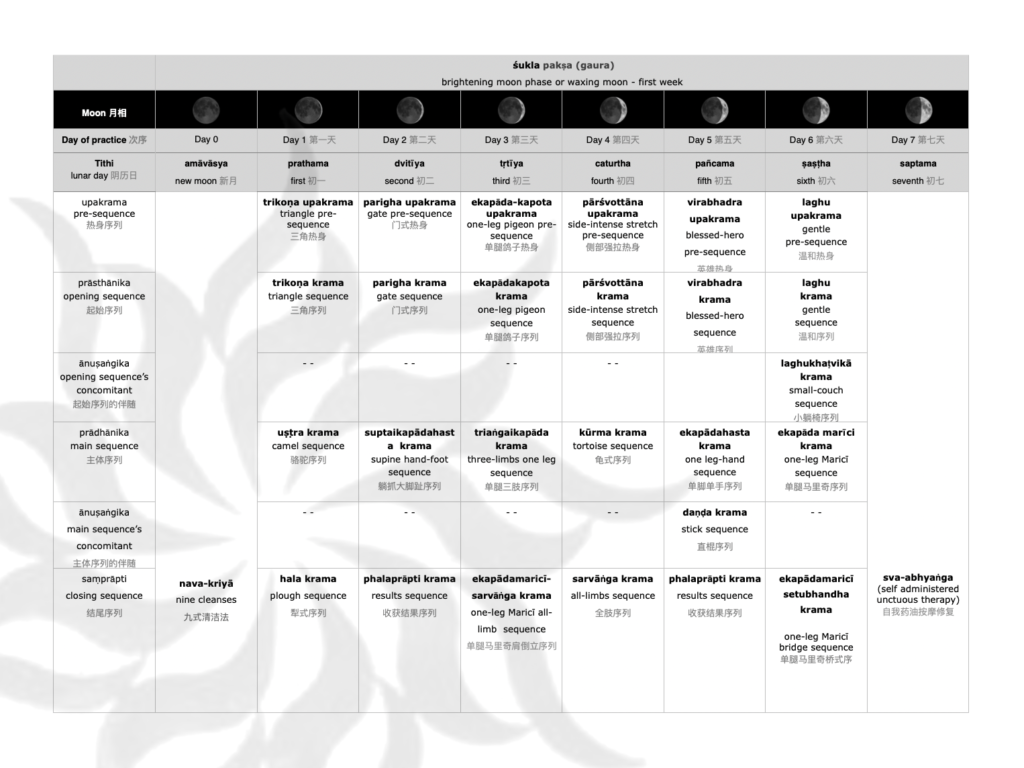
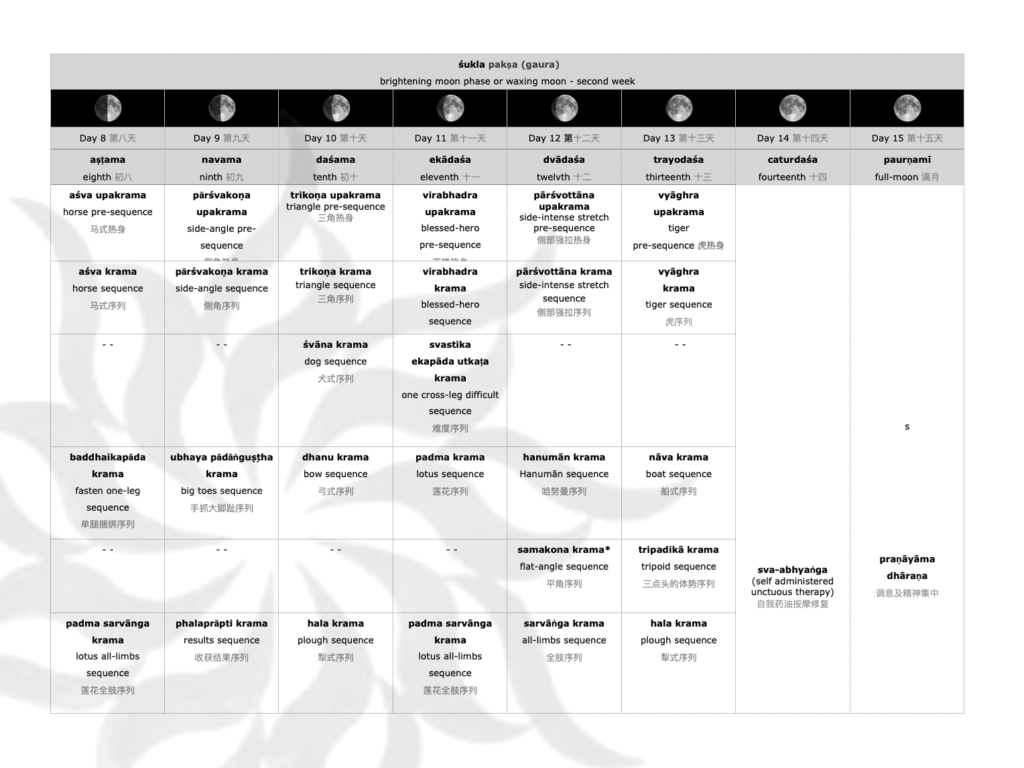
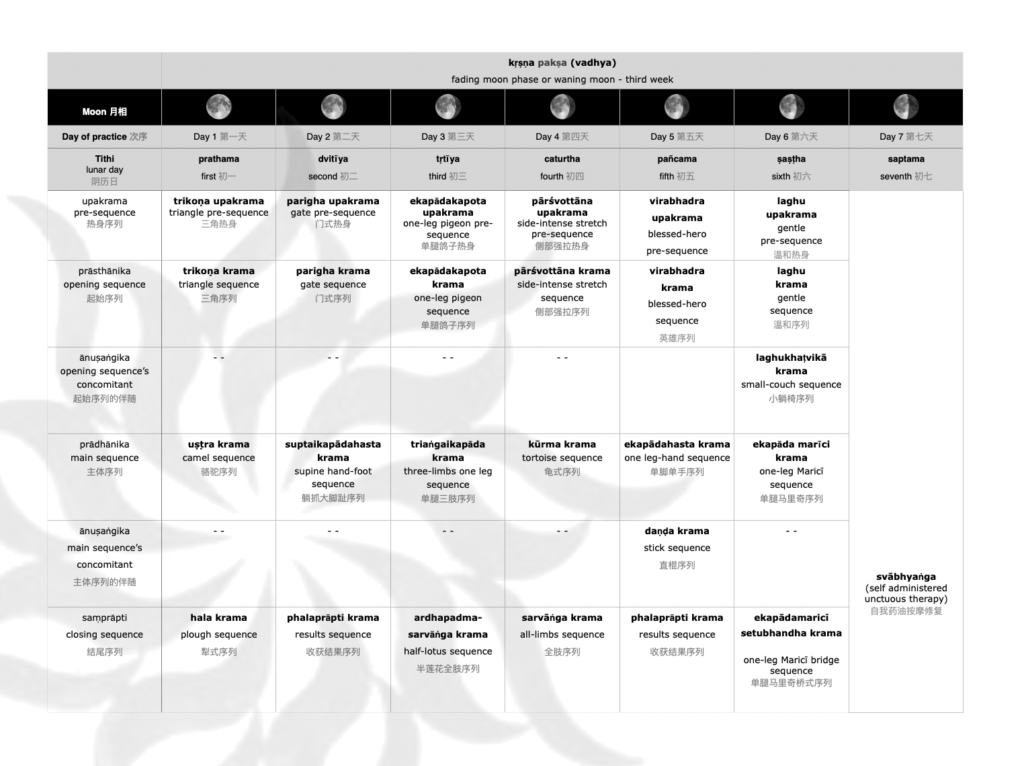
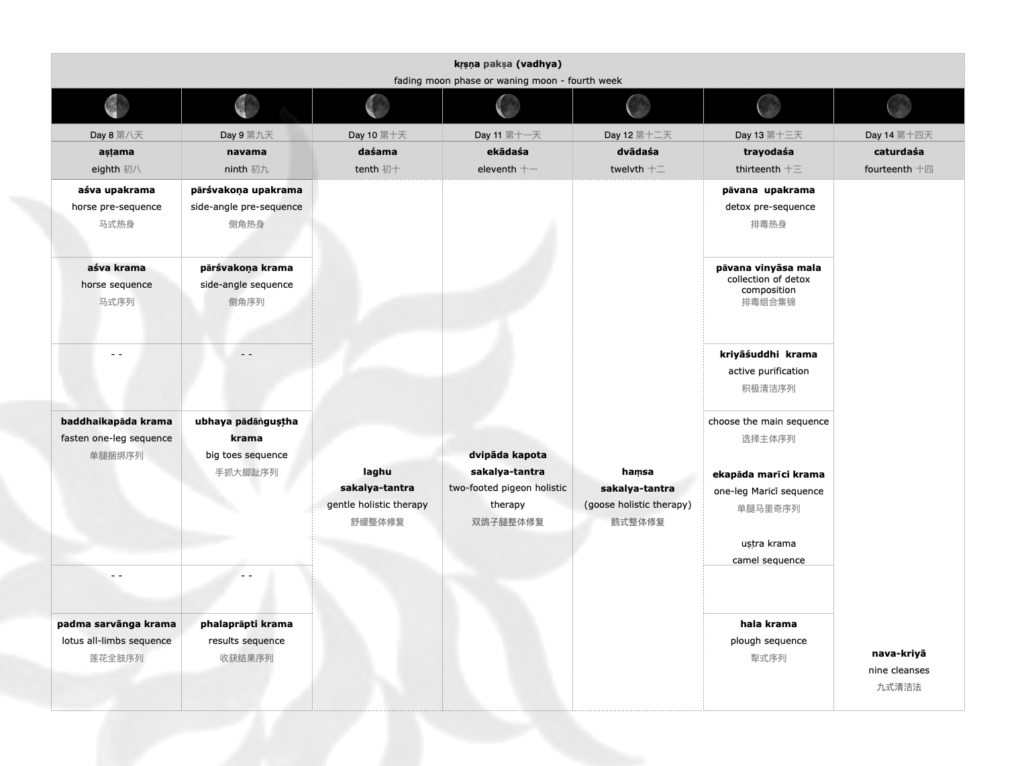
Navakaraṇa’s multidisciplinary method
Navakaraṇa vyāyāma is the outcome of different branch of knowledge like anatomy, kinesiology, psychology, body-manipulation, musicotherapie, praṇic-healing, tantric techniques of yoga and kriyā. It provides a wide range of technique for healing and transformation which can be personalised according to the individual.
The main objectives of “The Essentials” course are:
- creating lightness, flexibility, adaptability and strength of physique combined purity and calmness of the mind;
- provide a wide and systematic syllabus for both practice and teaching;
- create community that support every practitioner in personal and professional goals.
Upon competition of the 4-module course, practitioners can deepen the study and practice of Navakaraṇa with further courses such as:
- Life-style Course (Maulika Siddhānta);
- Advanced Series Course (Navakaraṇa Prakṛṣta);
- Teaching Skills Course (Navakaraṇa Śikṣā Paddhati)
- Movement Meditation Course (Navakaraṇa Sākalya Tantra)
- Philosophy Course (Navakaraṇa Mīmāṃsā).
Practitioners who are ready to progress spiritually are guided individually.
Navakaraṇa’s synergistic method
One of the most important principle of physical training is the rotation of anatomical focus. Rotation of anatomical focus means that if a practitioner worked on certain muscles on day-1; on day-2 he should work on different group of muscles. Changing of anatomical focus allows recovery and healing of the body.
Repetition of the same practice weakens the body, making it prone to injuries. For this reason, Navakaraṇa series are arranged synergistically. This means that series are arranged to optimise the results. Let’s use the first three series of Navakaraṇa Vinyāsa Mālā as an example:
Day-1
- “group A-muscle” elongating;
- “group B-muscle” contracting;
- “C-muscle” minimal engagement;
Day-2
- “group A-muscle” contracting;
- “group B-muscle” minimal engagement;
- “group C-muscle” elongating;
Day-3
- “group A-muscle” minimal engagement;
- “group B-muscle” elongating;
- “C-muscle” contracting.
In fact, when we say that Navakaraṇa has a synergistic approach it means that the interaction of series produces a “combined-effect” which is greater than what it would be by practicing each series separately. It is for this reason that in Navakaraṇa method a navakaraṇi practice a different series everyday for the whole period of waxing moon (i.e. 12 series in two weeks). During the first week of waning moon the navakaraṇi practices the first six series, while during the second week of waning moon he will closed the lunar month with a group of detox and restorative series and finally accomplish the practice of new moon day with a day of fasting and silence.
Choreography: the Art and Science of Sequencing
Navakaṛana choreography of movements and poses traces its origins from Karana and Nṛtta. These ancient sciences of movements and dance are much older than Haṭha-yoga for instance . We do not discuss in details Navakaraṇa’s choreography in this introduction as it is a vast and complex subject incomprehensible to anyone without having completed “Navakaraṇa Teaching Skills Course”. But there are some basic and important aspects of choreography which can help you comprehend Navakaraṇa better.
Viniyoga and Kinaesthetic progression
“Breath-movement application” (viniyoga) are choreographed in order to provide a kinaesthetic progression into the movement/pose (karaṇa). Kinaesthetic progression means that the sequencing of each “breath-movement application” (viniyoga) has been created in order to bring awareness of the position and movement of the parts of the body by means of sensory organs (proprioceptors) in the muscles and joints.
Through Navakaraṇa Kinaesthetic progression, the practitioner can achieve sensing, feeling awareness and control over the movement/pose with minimal instruction from the teacher. If the practitioner has memorised the sequence, no instructions are required. It is an inner-and intelligent practice.
Navakaṛana’s fundamental structure of the progression is given in six applications (viniyoga-s):
- inhale: provides identification of the base;
- exhale: provides identification of the lines and points of gravity;
- III. inhale: places body extremities in a particular orientation;
- IV. exhale: generates focus or sensing of the elongating / contracting muscles;
- inhale: generates energy (of the movement or pose);
- VI.exhale: create awareness and control (kinaesthesia) over the movement/pose.
This is one of the main reason why, in the Navakaraṇa method, all compositions (vinyāsa) are given with six counts.
Navakaraṇa is “intelligente practice” has it applies methodology which allows the practitioner apply knowledge acquired through the practice freely according to new circumstances and needs. Trough Navakaraṇa methodology that the practitioner can create everyday a new and useful practice simply by himself. He learns to personalised his own practice and progress at his own pace. An intelligent practice not only is optimal for his body but it also helps in developing introspection and creativity, At more subtle level it strengthens the character of the person in making choices and develop responsibility.
The karaṇa-system
The concept of karaṇa (unit of movement) is unique of Navakaraṇa method. The more you study and practice Navakaraṇa the more you realise how different this method from any other system. A unit of movement (karaṇa) as three parts: entry, stay and exit. Navakaraṇa sequencing is not based choreography of poses. It is based on choreography of entries and exits. What is generally referred as pose in other method, it is only a stay between entry and exit in Navakaraṇa.
According to Navakaraṇa there are two main categories of karaṇa (unit of movements): elongating (dairghya) and contracting (stambhana).
Elongating(dairghya) is further subdivided in
- pṛṣṭha-dairghya or posterior stretch;
- agra-dairghya or anterior stretch;
- pārśva-dairghya or side stretch;
- parivṛtta-dairghya or twisted stretch.
Contracting (dārḍhya) is further subdivided in:
- tejaskara or strengthening by contraction of core and forearms;
- aṅga-ādhāra or balancing on the limbs by stabilising different part of the body;
- viparīta or inverted by immobilising the body.
Further:
- neutral (sama) is the condition where stretching and strengthening occur in perfect balance.
- necovering (punarnavīkāra) is the condition where where stretching and strengthening occur at the minimal intensity.
Thus total number of categories and subcategory is nine. In order to have a complete practice the choreography of a sequence have to include all the nine (nava) units of movement (karaṇa). This is one of main reason why this method is called Nava-karaṇa Vinyāsa (lit. composition of nine unit of movements).
Freedom of practice
The most important aspect of the practice is not the poses but how the nine units of categories are choreographed synergistically. For this reason, a navakaraṇi can change the pose as it more beneficial while maintaining the choreography of the nine category unchanged (in order to keep the synergy of the movements). To achieve the best result of of the practice it is very important to personalise the practice while keeping the kinaesthetic progression and synergetic arrangements. Personalised practice speeds up progress and reduces injures. It also enhances creativity and empowers the practitioners both at physical and mental level.
Bodily proportion
The progression into the pose is built based on practitioner’s bodily proportion. This system is extremely accurate. Thus movements and poses are slighting different according to the individual’s anatomical body proportion. These principles and techniques are explained during the workshops and taught in details during the Teacher Training Courses.
Calligraphy and nomenclature
Navakaraṇa uses also a particular calligraphy and nomenclature for writing down the sequences. Navakaraṇa calligraphy which appears incompressible to anyone new to this method is actually clear and accurate to the navakaraṇi. In fact all the navakaraṇi does not need any drawing, photos or videos to understand the choreography of the sequence. This calligraphy allows practitioners and teachers to memories each viniyoga (or breath-movement application) of every sequence accurately and without forgetting any details.
Navakaraṇa Class
Navakaraṇa class led by a senior teacher has very uniques and peculiar features that you cannot find anywhere else. The voice of the teacher is tuned (śruti) to a tānapūrā (traditional four-stringed lute). The instructions are given with hand-clapping or with a traditional wooden block instrument (karatāla). The class is lead with tempo (laya) and melody (svara). The teacher gives minimal instructions with tālam (rhythmic beat) and Sanskrit recitation tuned to a sound pitch (nāda) to facilitate harmonious flow, rhythmic breathing, concentration and mental clarity. What could appear very odds at first it is in reality a very ancient practice of teaching vinyāsa which is practically extinguished in the course of time with the only exception of the Navakaraṇa method which is keeping this ancient tradition still alive.
Graduating
Practitioners receive the first graduation, upon completion of Navakaraṇa Vinyāsa Hṛdayam (The Essentials). At this point, the navakaraṇi knows how to practice and teach thirty-six sequences. These sequences can be taught as regular a vinyāsa class or can be taught as a de-construction class. A de-construction class explains one of the thirty-six vinyāsa sequences in detail. The kinaesthetic progression is given for every vinyāsa in the way that students can follow and memorise each breath-movement application (viniyoga). Students are also guided on how to progress into movements and personalise the poses according to their anatomical proportions. Experienced teachers can lead the traditional Navakaraṇa Vinyāsa classes, following the lunar-month routine.
Community
Another interesting aspect of Navakaraṇa method is the concept of a community (Kula). Navakaraṇa offers a methodology for practicing and teaching as well as a system of support which allows every Navakaraṇa teacher to conduct professional activities in symbiosis and harmony with the whole community.
Download the Introduction booklet:
English PDF – downloadable
Italian PDF – scaricabile
日本人 PDF – ダウンロード可能
中文 PDF – 可下载的
